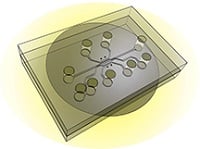 |
| Researchers have created a chip that mimics the microenvironment of a tumor.--Courtesy of Purdue University |
A Purdue University team has created a new chip that promises to help test how cancer-killing nanoparticles react in a tumor environment. Because different nanoparticles perform vastly different functions in drug delivery, it's important to determine early on what kind of effect they will have on a tumor and what it would take to improve their outcome.
The tumor-microenvironment-on-chip (T-MOC) simulates the kind of surroundings a nanoparticle will encounter inside cancer cells, one of which is an abundance of interstitial fluid that leads to higher pressure within the cells, pushing out treatments.
The T-MOC device is a matchbook-sized square with microfluidic channels containing tumor cells and endothelial cells, as well as the extracellular matrix, all of which allow for a detailed examination of what certain treatments will do in vivo. In petri dishes or animal tests, this environment does not translate as well to clinical trials, according to the university.
Thus, the system showed researchers how nanoparticles will move through the environment of breast cancer cells, playing a crucial role in how they deliver their cancer-killing payloads. The chip is detailed in a forthcoming study in the Journal of Controlled Release.
"Delivery of therapeutic agents selectively to tumor tissue, which is referred [to] as 'targeted delivery,' is one of the most ardently pursued goals of cancer therapy," the team, led by Bumsoo Han, wrote in the abstract. "… In spite of promising early results, the delivery and therapeutic efficacy of the majority of NPs [nanoparticles] are still quite limited. … The results suggest that T-MOC is capable of simulating the complex transport around the tumor, and providing detailed information about NP transport behavior. This finding confirms that NPs should be designed considering their dynamic interactions with tumor microenvironment."
Much about nanotechnology in drug delivery is still misunderstood, and although there is huge potential, coming to a clear understanding of what these particles will do in a human system is key to developing more effective cancer drugs.
- here's the Purdue announcement
- and here's FierceBiotechResearch's take